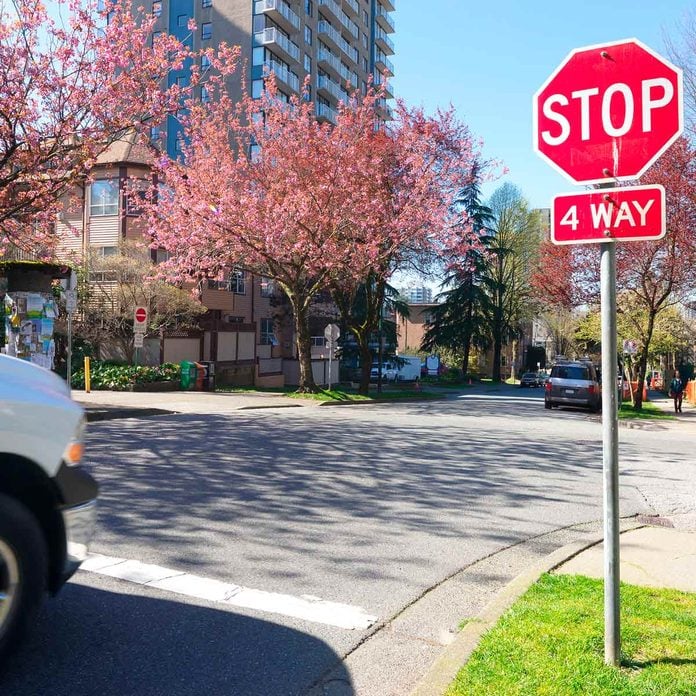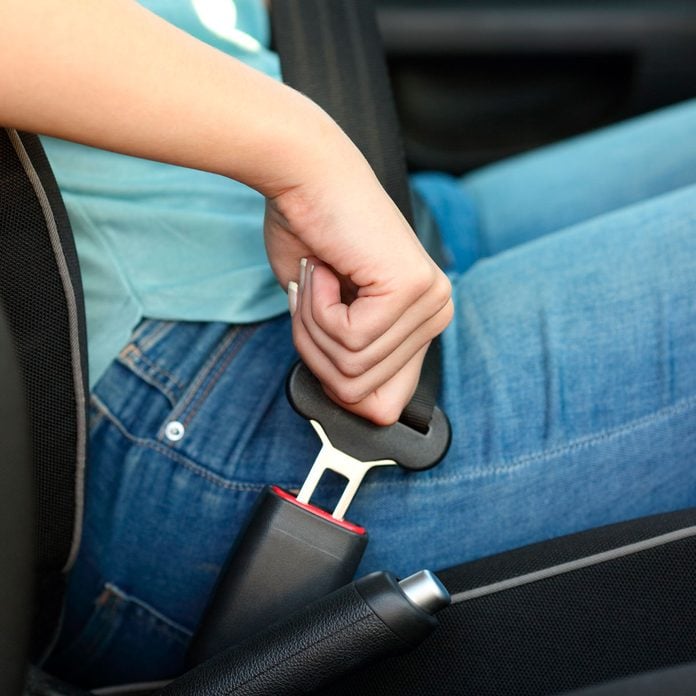
Speeding
No matter how long you’ve been driving, there’s a good chance you tend to speed every now and then. Even going 5 miles-per-hour over the limit is against the law. Curious about speed limits around the country? The National Motorists Association has this guide for every state.
Could you pass the driver’s test again? Find out with this quiz.

Not Stopping
Stop means stop—as in a full stop. It can be tempting to just slow down at a stop sign or red light when there’s no other traffic around, but police can issue a ticket for not coming to a complete stop at a stop sign or at a red light. “Red light running happens frequently and is often deadly. In 2017, 890 people were killed in crashes that involved red light running,” according to the Insurance Institute for Highway Safety (IIHS). In addition, an estimated 132,000 people were injured in red light running crashes in 2017.

Four-Way Stops
How many times have you pulled up at a four-way stop with three other cars, all at the same time, and nobody knows who should go first? The National Highway Traffic Safety Administration has this handy guide to help you understand how to proceed in this scenario. It basically breaks down like this: The general rule is that the first vehicle to arrive at the stop sign has the right of way. However, if two or more cars arrive at the exact same time, the car to the right owns the tie breaker and goes first.

Wearing Seat Belts
When your destination is just around the corner or a block away, it can be tempting to save time by not buckling up. But for much of the country, it’s one of those traffic rules that shouldn’t be ignored. Thirty-four states have primary seat belt laws for front seat occupants, and 29 states have laws enforcing rear seat belt use, according to the Governors Highway Safety Association.

Yielding
Driving laws require motorists to yield in various scenarios. The American Safety Council says right of way must be yielded to other drivers in the following instances:
• At a yield sign
• To pedestrians in a crosswalk
• To persons using a seeing eye guide dog
• To persons using a white cane with or without a red tip
• At uncontrolled intersections where vehicles are already in the intersection
• At “T” intersections where you must yield to vehicles on the through road
• When turning left in which case you must yield to oncoming pedestrians, cars, etc.
• When driving on an unpaved road that intersections with a paved road
• When returning to the roadway after the car is parked.

Tailgating
Tailgating is one of those traffic rules that can be easy to forget when you’re in a hurry. However, tailgating causes accidents. In fact, the National Highway Traffic Safety Administration says rear-end collisions account for 28 percent of highway accidents.
According to Drive-Safely.net, “At a MINIMUM, during dry weather conditions, you should have at least 2 seconds of space between you and the vehicle in front of you (3 seconds is better). Do this by using a fixed object such as a bridge, tree, or even a crack or shadow in the roadway. Once the rear bumper of the vehicle in front of you crosses that object, begin to count… one-thousand-one, one-thousand two, one-thousand three, etc. If you don’t make it to 2 by the time your front bumper crosses that same fixed object, you need to increase the following distance. Of course, being further away than 3 seconds isn’t only acceptable, it’s recommended.” You’ll regret leaving these 12 things in your car this summer.

Cell Phone Use
Answering that phone call or sending a quick text message while behind the wheel may not seem like a big deal, but it is. As of February 2019, 48 states ban text messaging for all drivers, according to the Insurance Institute for Highway Safety. In addition, 18 states prohibit all drivers from hand-held cell phones while driving. Learn more at StopTextsStopWrecks.org.

Pulling Over for Emergency Vehicles
You may be in a hurry, but if an emergency vehicle is headed your way with its lights and siren on, you need to get out of the way. All 50 states have some law regarding how drivers are required to yield to emergency vehicles. To see what the law is in your state, visit AAA Digest of Motor Laws.
You should always go to a car dealership for these 10 problems.

Cutting Through Parking Lots
It can be tempting to take a shortcut through a parking lot to avoid a busy intersection, but depending on where you live, it may be against the law. “This is an easy one,” Sgt. Jill Bennet with Michigan State Police Traffic Services Section told MLive.com. “Yes, it is illegal to cut across private property to avoid a traffic control device.” Different states, even different municipalities within states, have varying laws about this. Check your state’s vehicle code for specific laws. Never do these 13 things to your car.

Using Turn Signals
Turn signals help communicate your actions to other drivers, but it’s not uncommon for drivers to forgo using them. About 40 percent of a vehicle’s outer perimeter is hidden by blind spots, according to the U.S. Department of Transportation. “Failure to signal is illegal, inconsiderate and extremely dangerous to everyone in your vehicle and to all the road users around you,” the department notes. These are the five biggest car fails of all-time.